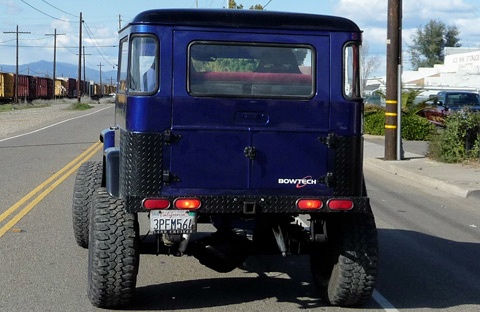Fish Report for 1-3-2018
Sideways driving vehicle

by Don Stec
1-3-2018
Website
Have you ever followed a vehicle that seemed to be going sideways on the road? If you were to watch it as it went around a curve, you would notice that the vehicle could not navigate the curve smoothly. It would move from side to side in the lane. I wonder, does the driver realize how dangerous this condition is?
I got a phone call from a government agency in a mountain town about 150 miles east of Redding. The caller said, “We have a small SUV that was involved in a collision and repaired, but now it drives sideways and no one in town can find out what’s wrong with it.”
How many inches off center is it, I asked? I expected her to say an inch or two, she replied, “about three feet.”
A rear axle that does not align with the front axle of the vehicle causes a vehicle to not track properly. Pickup trucks, especially 4X4 types are the most common vehicles to have this condition. Trucks that are lifted to gain more ground clearance are even more susceptible because any strain on the frame and running gear is increased. Often the cause is hitting a hole or running over a rock. A frame that has been damaged in a collision with another vehicle is also a common cause to not track properly.
Cars often have a tracking problem too. Hitting a curb or object in the road, especially for little light weight cars is common.
Some vehicles have adjustments on the rear axle and if the condition is slight, it may be adjustable, if not, the vehicle will require frame alignment repair.
It arrived at the shop a couple of days later. Out of curiosity, I asked the driver to drive down the road in front of the shop. I wanted to stand in the roadway and observe the vehicle for a hundred feet or so as it drove away from me. My purpose at this time was not to analyze the vehicle, but to get a perspective on what seemed an exaggeration on the description of three feet.
I have repaired many vehicles that drove sideways as much as six inches. One to three inches is more common. Six inches is considered extreme and a vehicle this far off would be very difficult to keep in a straight line and dangerous on mountain roads. It is especially dangerous during winter’s slippery road conditions. Locking up the brakes will cause the vehicle to spin into a circle. Towing a trailer is even more dangerous- it will increase the force and exaggerate the spin, resulting in a jackknife.
I was surprised to see the vehicle take up almost the entire traffic lane. Instead of looking over the hood, the driver was looking over the right front fender area to see the road straight ahead. As he turned the vehicle around and came back toward me I could see the right rear wheel almost on the dirt shoulder of the lane, while the left front wheel was hugging the centerline. It gave me the feeling of watching a circus clown vehicle. I visualized a bunch of clowns with red noses, painted white faces and big floppy shoes jumping out when it stopped.
The problem was the vehicle had a bent frame called a diamond condition. It was the most extreme I have ever seen on a vehicle that was still being driven. The left frame rail had been pushed forward more than six inches, causing the rear axle to point toward the right side, instead of following the front wheels.
This was a utility type SUV with a very strong frame, designed for highway and off road use. Amazingly, the vehicle body did not show very obviously damage but cross measuring the body revealed it too, was out of square. The driver did not complain about the doors being difficult to open and close but they were binding in the bent body. The impact must have been primarily on the bumper at the left rear corner, bending the frame and the body bending with it.
A vehicle frame is similar to a ladder. Imagine a ladder with one side bent ahead of the other side. The ladder would not stand vertical against a wall. A vehicle with the same condition would not drive straight on the road.
We placed the vehicle on the frame machine. It required pulling the frame and the body simultaneously. 10 tons of hydraulic pressure was required at each pulling tower on opposite sides, one in front of the vehicle the other on the rear. We gained inch by inch slowly, as we had to stress-relieve the body with the frame. This we accomplished with portable hydraulic jacks and large blocks of wood to distribute force evenly; so a large mass could be moved and not do jack damage to the body sheet metal.
It is always gratifying when a driver test drives a vehicle then comes back to tell you the vehicle drives like new again. In this case, the driver also commented on how much better the doors opened and closed.
The above is an extreme misalignment condition and required a more aggressive repair method than the typical collision repair. A misalignment this extreme on vehicles used by the general public would normally make the vehicle not movable and result in damage to mechanical parts.
Coachmaster Collision repair* is a past recipient of the District Attorneys award for honesty and integrity in business.
Don Stec is the founder of Coachmaster, a full service collision repair facility also specializing in the collision repair of RV’s. Now retired, Don is proud to have sold the business to long time manager Allan Gordon. Call Coachmaster at 530-243-1310, or stop by at 6851 Eastside Road. Redding, CA.
< Previous Report Next Report >
< Previous Report Next Report >
More Reports

12-20-2017
We’d just arrived at Lower Klamath and Tulelake. It was a waterfowler’s paradise. There were thousands of ducks and geese....... Read More
Hetch Hetchy
Hetch Hetchy Reservoir12-15-2017
According to visitation statistics from the National Park Service, a record five million people experienced Yosemite last year. Of these...... Read More

Website Hosting and Design provided by TECK.net